
What is Application Modernization: Your Ultimate Guide
Have you ever felt like your outdated software applications are holding your business back in the race to digital transformation?
Unlock the full potential of your business with a solid application modernization – your roadmap for transforming legacy software into modern, high-performing business assets.
Dive into our ultimate guide to application modernization and discover how to transform your outdated business applications into next-generation software systems. Uncover key strategies, accelerate your digital journey, and turn your software into a true competitive advantage!
What is application modernization?
Application modernization is the process of updating, upgrading, or transforming existing software applications to improve their functionality, performance, security, and user experience.
The primary goal of application modernization is to ensure that legacy or outdated applications remain relevant, efficient, and capable of meeting the evolving needs of an organization and its users.
Application modernization is driven by several factors, including the need to remain competitive, adapt to changing technology landscapes, improve security, optimize costs, and meet evolving user expectations.
It can take several forms, including rehosting (lifting and moving to a new platform), refactoring (restructuring code for better performance), rearchitecting (completely redesigning the code structure or application), or replacing (adopting a new software solution).
The specific approach chosen depends on the unique requirements and constraints of each organization, its internal architecture, and its legacy systems.
But what are these legacy systems really about?
Are they completely outdated software systems that require countless hours of refactoring? Or are they still useful for modern organizations?
Let’s answer these questions.
Application modernization – Improving legacy systems
Legacy software systems, also known as legacy software or legacy applications, refer to older and often obsolete computer systems, software applications, or technology platforms that are still in use within an organization or business.
These systems are considered “legacy” because they were typically developed using older technologies, programming languages, and architectures that may no longer be widely supported or conform to current industry standards and best practices.
When do applications become legacy?
Well, as Stratoflow CTO, Arkadiusz Drysch, has rather jokingly said:
“Well, basically any system that has been deployed in production can be regarded as a legacy application, as it requires constant maintenance. There’s no such thing in software development as write-and-forget architecture”.
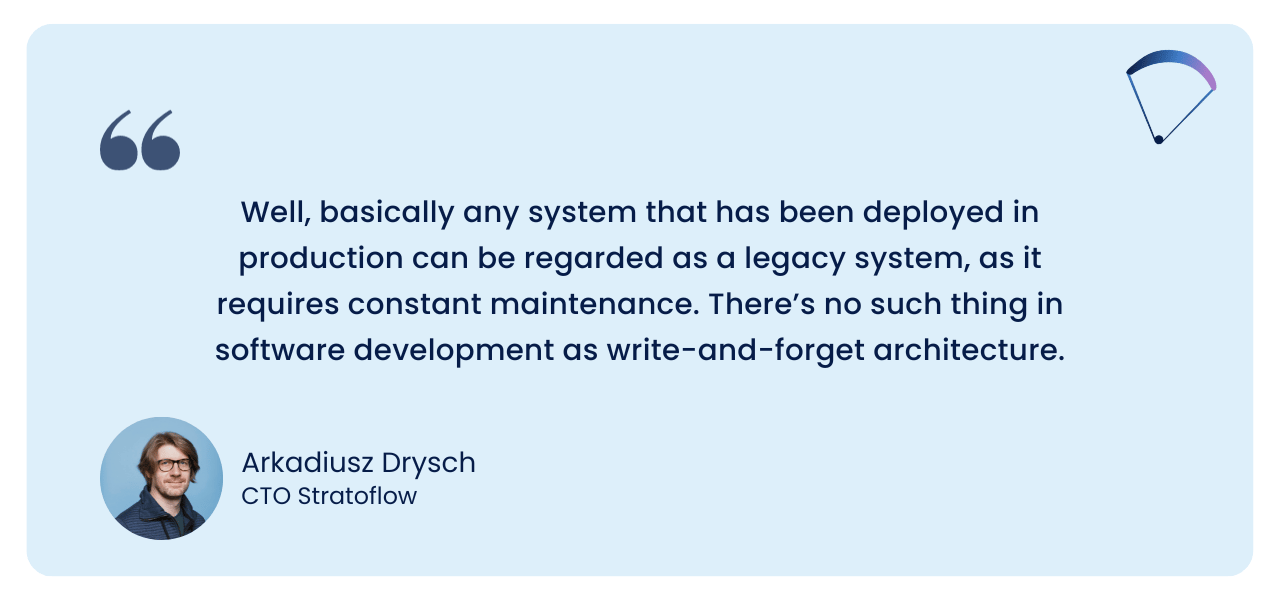
On a more serious note, we can differentiate are some key characteristics and aspects of legacy systems:
- Aging tech stack – Existing legacy applications are typically several years or even decades old. They often date back to a time when computing technology and custom software development practices were different from today’s.
- Limited scalability – Legacy systems may have limitations in terms of scalability and ability to handle modern workloads. They may not easily adapt to increased user demands or changing business needs.
- Poor performance – Today, subpar software performance can seriously hinder business processes. Some of the technology solutions and architectural designs don’t hold up as well after all these years and can seriously impact application performance.
- Maintenance issues – Maintaining and supporting legacy systems can be challenging due to a dwindling pool of experienced developers and a lack of software documentation. This can lead to increased maintenance costs and potential security risks.
- Integration challenges – System integration of legacy systems with newer technologies or third-party applications can be complex and costly. This can hinder an organization’s ability to streamline processes and access up-to-date data.
[Read also: Java Is Not Dead Yet! Why Is Java So Popular Even In 2023?]
Why, when, and how to modernize legacy applications?
Okay, so we can clearly see that legacy software can cause nothing but headaches.
Outdated tech stack, scalability, and performance issues.
It seems that all legacy software applications should be replaced because they are no longer competitive and cause more problems than they solve.
Is this really true?
No, not all legacy applications are unusable. Many legacy applications continue to provide essential functionality and support critical business processes. So we should associate the term “legacy” with the age of the application or the technology used in the application, not its usefulness.
The decision to conduct application modernization of old, legacy systems should be based on factors such as the strategic importance of the application, the limitations of current technology, and the business benefits of application modernization.
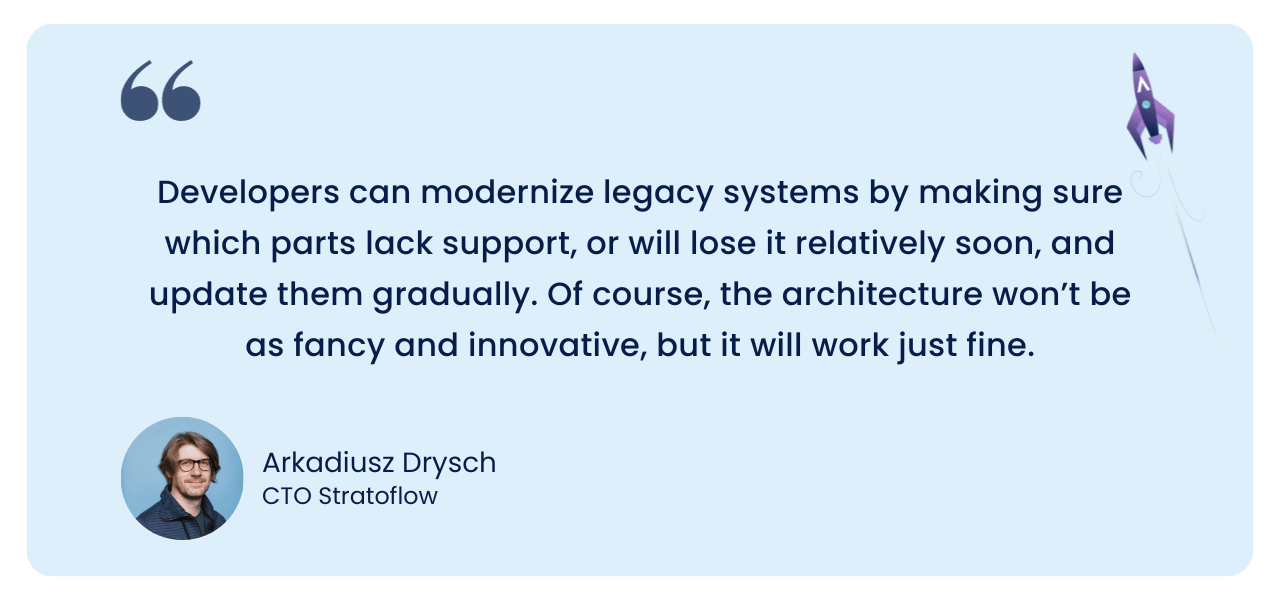
But let’s be real: modernizing legacy software can bring significant and positive change to organizations.
The process can be tedious and resource-intensive, but the results can strengthen the organization and open up entirely new competitive opportunities.
Benefits of application modernization
Application modernization can bring several significant benefits to organizations looking to remain competitive and agile in the evolving technology landscape.
Key benefits include:
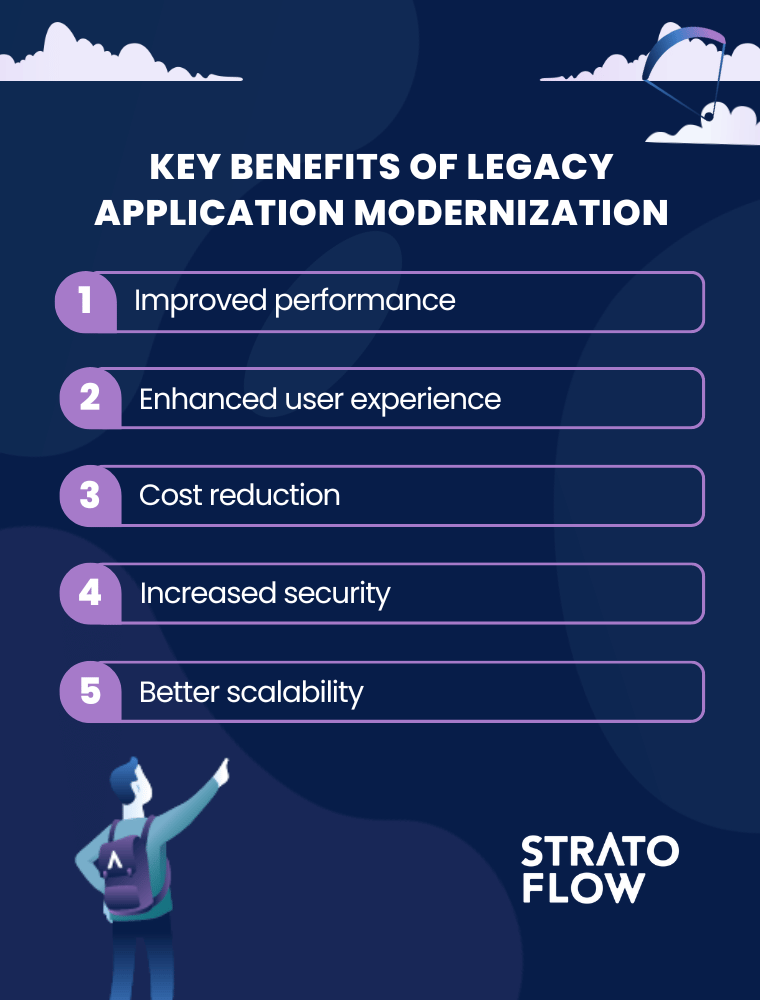
Improved performance
Application modernization often leads to significant performance improvements. Applications become more responsive, scalable, and capable of handling larger workloads, which enhances overall operational efficiency. efficiency
Enhanced user experience
Modernized user interfaces and improved usability result in a better user experience. This can lead to increased user satisfaction, higher productivity, and a competitive edge.
Cost reduction
Legacy systems can be costly to maintain, particularly due to the need for specialized skills and outdated infrastructure. Application modernization can lead to reduced maintenance and operational costs, contributing to long-term savings.
Increased security
Older apps are often more vulnerable to security threats.
It’s mostly due to outdated security practices and a lack of updates.
Application modernization efforts typically include cloud migration and security enhancements, reducing the organization’s exposure to cybersecurity risks.
Better scalability
Modernized systems are more scalable, allowing organizations to adapt to changing workloads and business requirements more easily. This scalability is often achieved through cloud-based or containerized solutions.
[Read also: How to Prepare a Successful Application Migration Project]
Importance of application modernization services
So how do you get access to all these strategic advantages?
Enter application modernization services.
Application modernization services refer to a range of consulting, development, and support offerings from IT service providers or consulting firms that help organizations update and improve their existing systems and infrastructure.
How do application modernization services benefit the modern enterprise?
First, application modernization services enable organizations to adopt agile methodologies – a set of practices that enable faster and more responsive development cycles. Modernized applications are built to take advantage of the latest technologies, ensuring high performance and the ability to scale with business needs. This is critical for organizations to handle growing workloads and seamlessly expand their operations.
It’s also important to note that when it comes to application modernization, the indispensable role of programming professionals becomes abundantly clear.
Their in-depth knowledge of the latest technologies and frameworks not only ensures a smooth transition, but also puts the application on a future-proof foundation. Only by working with a top-notch software development team can you ensure the preservation of core system functionality while introducing enhanced performance and security in application modernization projects.
[Read also: Your Essential Guide to Nearshore Software Development]
Key technologies for legacy application modernization
When speaking to “modernization,” organizations are typically aiming to take advantage of several key technologies:
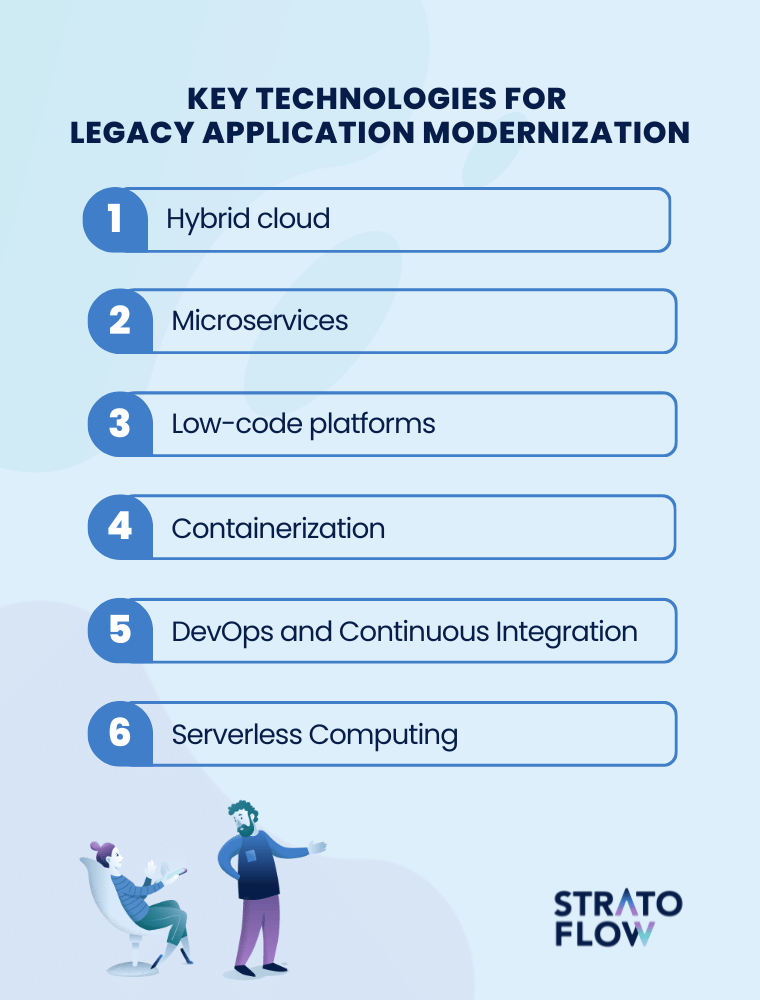
Hybrid cloud
Replatforming or rehosting applications on enterprise cloud platforms is a process that involves migrating existing applications, typically legacy or on-premises systems, to a cloud infrastructure with minimal changes to the application code.
That’s where hybrid cloud comes in as a cornerstone technology for executing application modernization efforts, providing organizations with a balanced and flexible hybrid platform that combines the best of both public and private cloud environments. Moving to a modern cloud platform offering can provide organizations with unparalleled flexibility and cloud scalability, allowing them to optimize their infrastructure based on changing workloads and requirements. This is critical for modernized applications that need to scale dynamically and efficiently.
Microservices
Most legacy software are monolithic applications, meaning that all components of a software application are bundled into a single code base and operate as a single unit.
This coupling makes them difficult to scale and maintain, as changes to one component can have cascading effects on others, leading to longer development and deployment cycles.
Moving from monolithic to microservices is a popular approach to application modernization can improve an organization’s scalability, development speed, fault isolation, technology flexibility, and ease of maintenance.
However, a monolithic application structure isn’t always a disadvantage; it can still be more appropriate for smaller projects, prototypes, and tightly integrated components. The Spring Modulith project exemplifies how a monolithic codebase can be modularized, providing a balanced approach that offers some of the benefits of microservices without the associated management overhead.
This case shows once again that software development is an extremely multifaceted field and the experience of programming professionals is truly indispensable.
Low-code platforms
In the quest for application modernization, low-code platforms are emerging as a key solution for business-oriented minds seeking efficiency and innovation.
Open-source low-code platforms like Openkoda drive rapid application development using drag-and-drop interfaces and standardized components, dramatically reducing both time and technical debt.
What does this mean for business executives?
Software development time can be reduced by up to 60%. An impressive result, to say the least.
Business leaders will find great value in the seamless integration capabilities of low-code platforms, which enable smooth connections between outdated legacy systems and modern applications, ensuring that technology stays in step with evolving business landscapes. A notable advantage lies in the scalability and performance attributes of the platforms, which overcome the limitations commonly associated with legacy systems.
Containerization
Containers are a form of virtualization that allows you to package an application along with its environment, libraries, and dependencies in a platform-independent manner.
When conducting application modernization, legacy applications can be broken down into microservices, with each service containerized and modernized incrementally. Containerization ensures that even older software apps run consistently across environments, reducing the “it works on my machine” problem.
Containers enable faster and more reliable application deployment, reducing downtime and increasing availability.
DevOps and Continuous Integration
DevOps and Continuous Delivery (CI) are a set of practices and principles that aim to improve collaboration and communication between software development (Dev) and IT and operations (Ops) teams. These modern software development methodologies thereby enhance the ability of organizations to deliver software more efficiently, improve its quality, and better respond to changing requirements.
- DevOps encourages frequent code releases and continuous feedback, allowing teams to identify and address issues promptly
- Continuous Integration involves automated testing, which ensures that any changes made to the legacy system do not introduce new errors or regressions.
- DevOps promotes making small, incremental changes, which can be particularly beneficial when modernizing applications, as it reduces risks and allows for more controlled updates.
Serverless Computing
Serverless computing is a cloud computing execution model in which cloud providers automatically manage the infrastructure for application deployment in their data center. Developers write and deploy code, and the cloud provider charges based on the actual amount of resources consumed by the executions. This approach can help modernize existing apps in a number of ways:
- It abstracts and manages the underlying infrastructure, reducing the operational overhead. Developers can focus solely on writing code, while the cloud provider handles server provisioning, maintenance, scaling, and updates, thereby accelerating the modernization process,
- Serverless applications automatically scale with the number of requests or events, without the need for manual intervention. This ensures that modernized applications can handle varying loads efficiently,
- Serverless architectures facilitate rapid development, testing, and deployment of applications due to reduced infrastructure management. This can greatly accelerate the modernization process.
[Read also: Digital Transformation in Finance: All You Need to Know]
5-Step Legacy Applications Modernization Strategy
In an era where digital transformation is no longer a luxury, but a necessity, modernizing applications is becoming a critical step for organizations looking to remain competitive and agile.
Application modernization projects are no easy feat.
There are countless moving parts, obsolete technologies, and issues with finding proper documentation.
That’s why application modernization strategies are so important when embarking on this journey. Here, we’ve proposed our most comprehensive 5-step approach for a successful application modernization strategy that will surely make your digital transformation journey much easier.
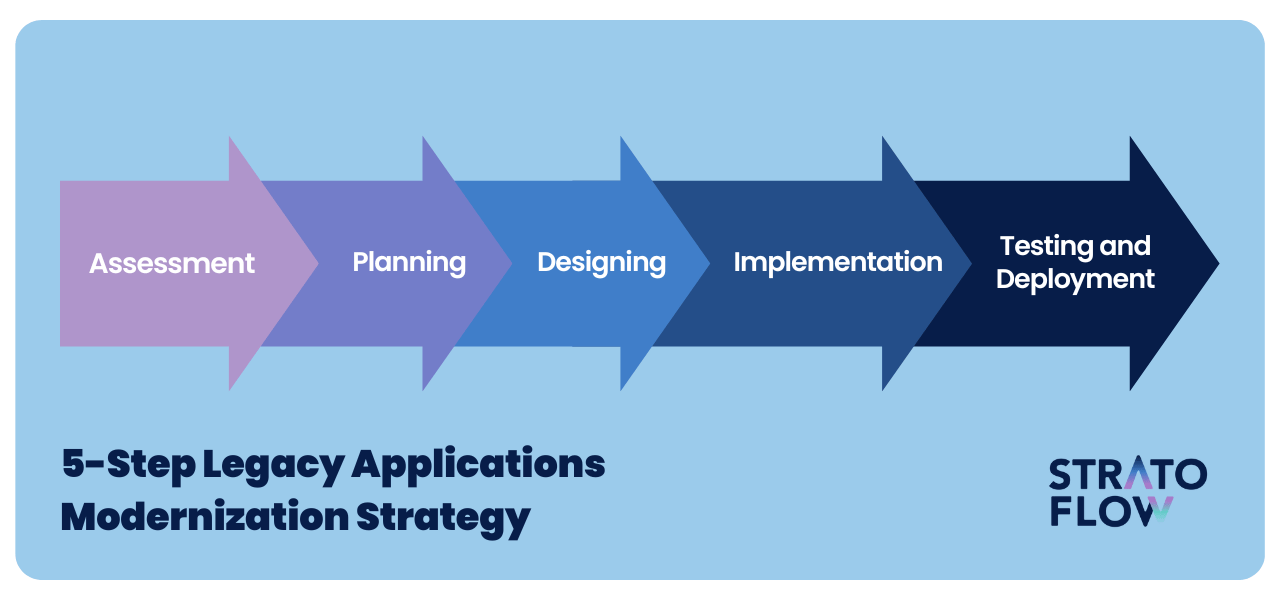
Step 1: Assessment
Begin your modernization journey with a comprehensive assessment and analysis of your legacy applications.
This critical phase involves creating an inventory of all existing applications, meticulously documenting their architecture, technology stack, dependencies, and level of importance to your business. It also involves assessing the performance bottlenecks, security vulnerabilities, and maintenance challenges associated with each application.
Ask yourself questions like, “How well do I understand the current state of each application in my portfolio?”, “Do we have an overview of existing apps and system dependencies, usage patterns, technical debt, and alignment with business goals?
Only then can you decide on the next step in your plan.
Also consider performing a thorough cost analysis to determine the total cost of ownership (TCO) for each legacy application, including maintenance, licensing and infrastructure costs. Don’t forget to identify any regulatory compliance requirements that these applications must meet.
Step 2: Planning
Once you have a clear understanding of your legacy landscape, define your modernization goals based on your assessment findings and overarching business objectives.
These goals should align with your organization’s vision for IT transformation.
It’s important to prioritize which applications to modernize first, considering factors such as return on investment (ROI), strategic importance, and technical feasibility. These goals may include improving application performance, enhancing the user experience, reducing operational costs, strengthening security measures, and improving integration capabilities.
Step 3: Designing
Once the plan is in place, select the appropriate modernization approach for each legacy application based on its unique characteristics and requirements.
You’ll likely encounter a range of scenarios, including the option to lift and shift applications to modern infrastructure platforms such as the cloud without extensive code changes.
For some applications, refactoring the existing code base to optimize performance and scalability while preserving core functionality may be the right approach.
Others may benefit from a complete architectural redesign that embraces modern paradigms such as microservices, serverless computing, or containerization. In some cases, replacing the legacy application altogether with a commercial off-the-shelf (COTS) solution or a new, custom-built application may make sense.
Step 4: Implementation
With your modernization approach selected, it’s time to create a comprehensive roadmap and implementation plan.
This detailed plan should include timelines, milestones, resource allocation, and all essential aspects of your modernization initiative. Define project phases to make the modernization process manageable and less disruptive.
Specify the technology stack, frameworks, and tools that will be used throughout the project. Develop a robust testing and quality assurance process to ensure the reliability and quality of the modernized application.
In addition, plan for user training and change management to facilitate a smooth transition to the modernized system. Finally, establish post-modernization monitoring and maintenance procedures to ensure continued success.
Step 5: Testing and Deployment
With your roadmap and implementation plan in place, it’s time to execute the modernization plan according to the timelines and milestones you’ve established.
Throughout this phase, closely monitor progress and promptly address any issues that arise.
Execute the development, testing, and deployment phases, ensuring rigorous testing and quality assurance. User acceptance testing (UAT) is a critical step that involves end users to ensure that the modernized application meets their needs and expectations.
Gradually roll out the modernized application, taking into account user training and support to ensure a seamless transition. Continually monitor the performance and security of the application and make improvements as needed. Gather feedback from users and stakeholders and use it to make iterative improvements. Remember that modernization is an ongoing process, and staying adaptable and responsive to changing technology landscapes and business needs is key to long-term success.
Conclusion
As you navigate the myriad paths of digital transformation, our Application Modernization Guide will provide you with the insights, methodologies, and actionable steps to revitalize your existing application landscape.
By implementing the strategies outlined in this guide, you can transform your existing applications into dynamic, agile assets that unlock new potential and ensure your organization is well-positioned to thrive in the ever-evolving digital landscape.
Related Posts
- How to Build a Document Management System: Alternative Approach
- How to Prepare a Successful Application Migration Project
- Best AI for Coding: Top 10 AI Tools for Software Developers in 2025
- Software Development Process: Complete 2025 Guide
- Complete Guide To Replatforming – Definition and Best Practices
Thank you for taking the time to read our blog post!